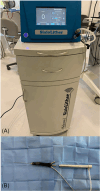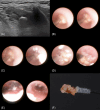Clinical Efficacy and Outcomes of Electro-Pneumatic Intracorporeal Lithotripsy in the Management of Sialolithiasis
- PMID: 39867918
- PMCID: PMC11764989
- DOI: 10.1002/oto2.70080
Clinical Efficacy and Outcomes of Electro-Pneumatic Intracorporeal Lithotripsy in the Management of Sialolithiasis
Abstract
Objective: This study aims to evaluate the clinical efficacy of electro-pneumatic intracorporeal lithotripsy for the treatment of salivary gland stones.
Study design: A prospective cohort study of patients diagnosed with obstructive salivary gland syndrome, where basket-assisted sialendoscopy alone failed to remove the calculi.
Setting: This study was conducted at the "Queen Maria" Military Hospital in Brașov, Romania, and a private practice, between February 2023 and May 2024.
Methods: A total of 29 patients with salivary calculi were treated using the SialoLither device (Hidromed), which operates on the electro-pneumatic principle. The number of sessions required for complete stone removal, the duration of each session, and the number of ballistic impulses applied were recorded. Statistical analyses, including the Mann-Whitney U test and multiple linear regression, were conducted to assess the relationship between stone size, location, and treatment outcomes.
Results: Complete removal was achieved in 72.4% of patients after a single session, with 100% success after 3 sessions. The average number of impulses was 13.9 (±4.25), with no significant difference in outcomes between the parotid and submandibular glands (P > .05). The total duration varied, with a mean time of 89.97 (±54.89) minutes. Complications were minimal, with only 2 cases of minor epithelial damage.
Conclusion: Electro-pneumatic intracorporeal lithotripsy is a highly effective, minimally invasive technique for managing salivary calculi, offering a safe and efficient alternative to traditional surgical methods.
Keywords: calculus removal; electrohydraulic lithotripsy; intracorporeal lithotripsy; minimally invasive surgery; pneumatic lithotripsy; salivary gland obstruction; salivary gland stones; sialendoscopy; sialolithiasis.
© 2025 The Author(s). OTO Open published by Wiley Periodicals LLC on behalf of American Academy of Otolaryngology‐Head and Neck Surgery Foundation.
Conflict of interest statement
The authors declare that there is no conflict of interest.
Figures


References
-
- Karwowska NN, Turner MD. Etiology, diagnosis, and surgical management of obstructive salivary gland disease. Front Oral Maxillofac Med. 2021;3(0):17. 10.21037/FOMM-20-73/COIF - DOI
-
- Gundlach P, Hopf J, Linnarz M. Introduction of a new diagnostic procedure: salivary duct endoscopy (sialendoscopy) clinical evaluation of sialendoscopy, sialography, and x‐ray imaging. Endosc Surg Allied Technol. 1994;2(6):294‐296. https://pubmed.ncbi.nlm.nih.gov/7704548/ - PubMed
LinkOut - more resources
Full Text Sources

